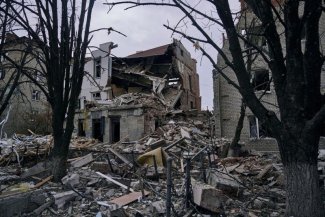Weather conditions force the front to stabilise. Day 417 of the war

The situation on the front has not changed significantly, and damp fields and muddy roads are significantly limiting the invaders’ ability to conduct offensive operations outside the town centre. Wagner Group troops are constantly storming Ukrainian positions in the western part of Bakhmut, but are not having any meaningful successes.
Despite the Easter holiday celebrated by Orthodox Christians, Russian shelling and missile attacks on civilian facilities have intensified in recent days. On 14 April, eight missiles fired from S-300 systems fell on Sloviansk, hitting a four-story apartment building among other sites, killing 15 civilians and wounding another 24. It was the deadliest missile attack on the city in more than six months. The invaders also continuously shelled towns along the Dnipro from Zaporizhzhia to the river mouth, most notably Nikopol, Beryslav and Kherson. The use of guided aerial bombs has also been reported, including in the border regions of the Chernihiv and Sumy oblasts.
On 17 April, Slovakia’s defence minister Jaroslav Nad’ announced that his country has already delivered all the MiG-29 aircraft it promised (13 units) to Ukraine. Repair and renovation work is underway as part of the Danish-German-Dutch project to transfer a minimum of 100 Leopard 1A5 tanks, which began in February. The tanks had been in storage for a long time, so bringing them up to combat readiness requires more time. According to Denmark’s acting defence minister Troels Lund Poulsen, the first Leopard 1A5s for training Ukrainian crews will be delivered in the next few weeks. Meanwhile on 14 April, the head of Canada’s Ministry of National Defence, Anita Anand, announced that all eight of the Leopard 2A4 tanks her country had promised Kyiv had been transported to Polish territory.
When Ukraine’s defence minister Oleksiy Reznikov was asked during an interview with the Spanish newspaper La Razón why the necessary weapons had not yet been supplied to Ukraine, he stated that the West “has long lived under the dogma of not provoking Russia”. Referring to Ukraine’s defence needs, he stated that the priority was to create an effective and modern air defence system. He pointed out that the MiG-29 fighter jets there can only attack at distances of up to 30 km, while Russia’s Su-35s can strike from a distance of 150 km. According to Reznikov, Ukraine needs to break Russian dominance in the air; this can be achieved with F-16s, Swedish Gripens or other modern designs. Referring to Ukrainian losses on the front, he pointed out that “they are critically lower than Russian losses”, and lower than the death toll from the March earthquake in Turkey (where more than 45,000 people died).
On 16 April Andriy Yermak, chief of the Office of the President of Ukraine, announced that the final stage of the Easter prisoner exchange had been completed. 130 soldiers were returned from captivity, including some who had been fighting in the Bakhmut and Soledar regions. Earlier, 48 were declared missing. The oldest of those freed is 58, and the youngest is 21. 230 soldiers have returned to Ukraine in the past week, and 2235 since the invasion began.
On the same day, the Ukrainian General Staff revealed that Russian defence minister Sergei Shoigu has decided to postpone the start of officer training at some military universities from 1 September to 1 December. This signals that they are having a problem with recruiting candidates. The Russians are continuing to send small groups of freshly trained soldiers to combat areas to replenish unit losses. The private military company Wagner Group is continuing to recruit mercenaries, and has not – contrary to some reports – been abandoned.
Also on 16 April, the Ukrainian government reported that the so-called regional occupation administrations have been ordered to hand lists of people with Russian passports over to local military commissions. These actions imply that the Russian army intends to use the local population, who have often been forced to adopt Russian citizenship, to supply its troops.
On 15 April, Russian authorities suspended the operation of the civilian port of Sevastopol. The official announcement cited “preventive” work to improve defences against sabotage and submarine drone attacks as the reason for the move.
A day earlier, Ukraine’s deputy defence minister Hanna Malar warned that the Russian disinformation operation is focused on falsifying the picture of the situation in Bakhmut and promoting the thesis that the Ukrainian command is not sparing the lives of its own soldiers. This is intended to undermine trust in the Ukrainian commanders and create discontent among the country’s people. Oleksiy Danilov, Secretary of the National Security and Defence Council of Ukraine, indicated that the threat of hostile attempts to destabilise the country is growing. He acknowledged that there are a large number of “traitors and collaborators” in the country; he said such people will take actions to confuse society, for example by resorting to demands for parliamentary or presidential elections.
Belarus’s defence minister Viktar Khrenin stated on 14 April that once tactical nuclear weapons are deployed in Belarus, only the Russian side will be able to use them. Work is underway to adapt the storage facilities where they will be stored. He added that if necessary, strategic nuclear weapons would also be placed in the country. The Belarusian defence ministry also reported that Russian instructors have completed the training of Su-25 aircraft pilots in “the use of modern airborne means of destruction, including special munitions”.
Commentary
- The rains that have been falling for several weeks (snow even fell in the Donbas in early April) have softened the ground and caused local flooding. The weather conditions are making it much harder for both armies to operate, as well as contributing to increased equipment and fuel consumption, and leading the soldiers to physical and mental exhaustion. Only tracked vehicles can repeatedly cross the dirt roads, which makes the delivery of supplies to positions much more difficult. As the front runs mostly through the ‘black earth’ zone, where the soil retains water for an exceptionally long time, these difficult conditions may persist for the next few weeks, or even longer. It is expected that both sides will limit offensive operations during this period (except in urban areas).




